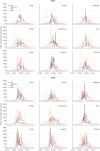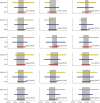1. Hong SJ, Ahn KM, Lee SY, Kim KE. The prevalence of asthma and allergic diseases in Korean children. Korean J Pediatr. 2008; 51:343–350.
2. Jee HM, Kim KW, Kim CS, Sohn MH, Shin DC, Kim KE. Prevalence of asthma, rhinitis and eczema in Korean children using the International Study of Asthma and Allergies in Childhood (ISAAC) questionnaires. Pediatr Allergy Respir Dis. 2009; 19:165–172.
4. Kim KR, Kim M, Choe HS, Han MJ, Lee HR, Oh JW, et al. A biology-driven receptor model for daily pollen allergy risk in Korea based on Weibull probability density function. Int J Biometeorol. 2017; 61:259–272.


6. Hong CS. Pollen allergy plants in Korea. Allergy Asthma Respir Dis. 2015; 3:239–254.

7. Beggs PJ. Impacts of climate change on aeroallergens: past and future. Clin Exp Allergy. 2004; 34:1507–1513.


8. D'Amato G, Holgate ST, Pawankar R, Ledford DK, Cecchi L, Al-Ahmad M, et al. Meteorological conditions, climate change, new emerging factors, and asthma and related allergic disorders. A statement of the World Allergy Organization. World Allergy Organ J. 2015; 8:25.


9. Kim KR, Park H, Lee H, Kim MJ, Choi Y, Oh J. Development and evaluation of the forecast models for daily pollen allergy. Korean J Agric For Meteorol. 2012; 14:265–268.

10. Grinn-Gofroń A, Strzelczak A. Artificial neural network models of relationships between Alternaria spores and meteorological factors in Szczecin (Poland). Int J Biometeorol. 2008; 52:859–868.


11. Puc M. Artificial neural network model of the relationship between Betula pollen and meteorological factors in Szczecin (Poland). Int J Biometeorol. 2012; 56:395–401.


12. Iglesias-Otero MA, Fernández-González M, Rodríguez-Caride D, Astray G, Mejuto JC, Rodríquez-Rajo FJ. A model to forecast the risk periods of Plantago pollen allergy by using the ANN methodology. Aerobiologia (Bologna). 2015; 31:201–211.

13. Astray G, Fernández-González M, Rodríguez-Rajo FJ, López D, Mejuto JC. Airborne castanea pollen forecasting model for ecological and allergological implementation. Sci Total Environ. 2016; 548-549:110–121.


14. NIMS. Current status of pollen observational network in Korea and application of the data. Technical note series NIMS-TN-2015-011. Seogwipo: NIMS;2015.
15. Breiman L. Bagging predictors. Mach Learn. 1996; 24:123–140.

16. Efron B. Bootstrap methods: another look at the jackknife. Ann Stat. 1979; 7:1–26.

17. Efron B, Tibshirani RJ. An introduction to the bootstrap. Boca Raton (FL): Chapman and Hall/CRC;1994.
18. Hinton GE, Osindero S, Teh YW. A fast learning algorithm for deep belief nets. Neural Comput. 2006; 18:1527–1554.


19. Rumelhart DE, Hinton GE, Williams RJ. Learning representations by back-propagating errors. Nature. 1986; 323:533–536.

20. Bourlard H, Kamp Y. Auto-association by multilayer perceptrons and singular value decomposition. Biol Cybern. 1988; 59:291–294.


21. Hinton GE, Zemel RS. Autoencoders, minimum description length, and Helmholtz free energy. Adv Neural Inf Process Syst. 1994; 6:3–10.
22. Bengio Y, Lamblin P, Popovici D, Larochelle H. Greedy layer-wise training of deep networks. In : Schölkopf B, Platt J, Hoffman T, editors. Advances in neural information processing systems, vol. 19. Cambridge (MA): MIT Press;2007. p. 153–160.
23. Crouzy B, Stella M, Konzelmann T, Calpini B, Clot B. All-optical automatic pollen identification: towards an operational system. Atmos Environ. 2016; 140:202–212.

24. Oteros J, Pusch G, Weichenmeier I, Heimann U, Möller R, Röseler S, et al. Automatic and online pollen monitoring. Int Arch Allergy Immunol. 2015; 167:158–166.


25. Kawashima S, Thibaudon M, Matsuda S, Fujita T, Lemonis N, Clot B, et al. Automated pollen monitoring system using laser optics for observing seasonal changes in the concentration of total airborne pollen. Aerobiologia (Bologna). 2017; 33:351–362.

26. O'Connor DJ, Healy DA, Hellebust S, Buters JT, Sodeau JR. Using the WIBS-4 (Waveband Integrated Bioaerosol Sensor) technique for the on-line detection of pollen grains. Aerosol Sci Technol. 2014; 48:341–349.
27. Wagner J, Macher J. Automated spore measurements using microscopy, image analysis, and peak recognition of near-monodisperse aerosols. Aerosol Sci Technol. 2012; 46:862–873.

28. Zhang J. Developing robust non-linear models through bootstrap aggregated neural networks. Neurocomputing. 1999; 25:93–113.

29. Franke J, Neumann MH. Bootstrapping neural networks. Neural Comput. 2000; 12:1929–1949.


30. Ha K, Cho S, MacLachlan D. Response models based on bagging neural networks. J Interact Market. 2005; 19:17–30.

31. Granitto PM, Verdes PF, Ceccatto HA. Neural network ensembles: evaluation of aggregation algorithms. Artif Intell. 2005; 163:139–162.

32. Tiwari MK, Chatterjee C. Uncertainty assessment and ensemble flood forecasting using bootstrap based artificial neural networks (BANNs). J Hydrol (Amst). 2010; 382:20–33.

33. Wen G, Hou Z, Li H, Li D, Jiang L, Xun E. Ensemble of deep neural networks with probability-based fusion for facial expression recognition. Cognit Comput. 2017; 9:597–610.

34. Geem ZW, Kim JH, Loganathan GV. A new heuristic optimization algorithm: harmony search. Simulation. 2001; 76:60–68.

35. Kulluk S, Ozbakir L, Baykasoglu A. Self-adaptive global best harmony search algorithm for training neural networks. Procedia Comput Sci. 2011; 3:282–286.

36. In : Rosa GH, Papa JP, Marana AN, Scheirer WJ, Cox DD, editors. Fine-tuning convolutional neural networks using harmony search. 20th Iberoamerican Congress; 2015 Nov 9–12; Montevideo, Uruguay. Geneva: Springer;2015. 10. p. 683.
37. Papa JP, Scheirer W, Cox DD. Fine-tuning deep belief networks using harmony search. Appl Soft Comput. 2016; 46:875–885.










 PDF
PDF ePub
ePub Citation
Citation Print
Print






 XML Download
XML Download